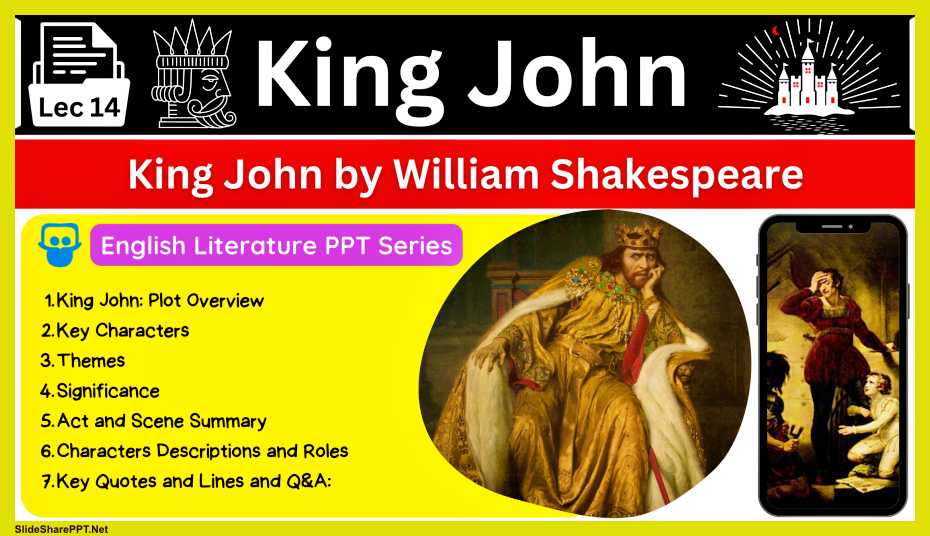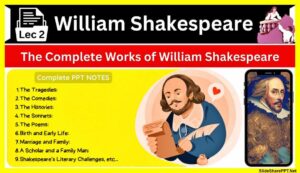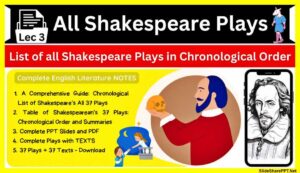King John by William Shakespeare PPT Slides & PDF
Contents
- 1 King John by William Shakespeare PPT Slides & PDF
- 1.1 King John by William Shakespeare
- 1.2 King John by William Shakespeare PPT Slides
- 1.3 (Lec 14)
- 1.4 A Complete Guide to Shakespeare’s “King John”
- 1.5 Plot Overview
- 1.6 Key Characters
- 1.7 Themes
- 1.8 Significance
- 1.9 Act and Scene Summary
- 1.10 Characters Descriptions and Roles
- 1.11 Key Quotes and Lines
- 1.12 Q&A:
Today we have shared the Notes of King John by William Shakespeare PPT Slides & PDF with Complete Play Texts. So, as we know William Shakespeare’s plays are renowned for their deep insights into human nature, complex characters, and timeless themes. Among his lesser-known works, “King John” stands out as a compelling exploration of power dynamics, political intrigue, and personal ambition. Written in the early 1590s, this historical drama delves into the tumultuous reign of King John of England, weaving together themes of loyalty, betrayal, and the consequences of unchecked authority. As we delve into this lesser-explored gem of Shakespeare’s canon, we uncover rich characterizations, intricate plot developments, and resonant themes that continue to captivate audiences and scholars alike. In this Article, we set the stage for our journey into the world of “King John,” highlighting its historical context, key characters, and enduring relevance in today’s world of politics and power struggles.
King John by William Shakespeare
Here’s a complete table for “King John”:
| Aspect | Description |
|---|---|
| Title | King John |
| Playwright | William Shakespeare |
| Genre | Historical drama |
| Date of Composition | Estimated to be between 1595 and 1596 |
| Setting | England and France during the early 13th century |
| Main Characters | King John, Philip the Bastard (Richard Plantagenet), Constance, Prince Arthur, Queen Eleanor, Cardinal Pandulph, Hubert de Burgh, King Philip II of France |
| Plot Overview | The play dramatizes the reign of King John of England and his struggles to maintain power amidst political turmoil, conflicts with France, and challenges to his legitimacy. It explores themes of loyalty, betrayal, and the consequences of political ambition. |
| Key Themes | Power and legitimacy, loyalty and betrayal, political intrigue, the burdens of kingship, the role of fate and fortune |
| Significance | “King John” is one of Shakespeare’s lesser-known history plays but offers valuable insights into the complexities of medieval politics and the dynamics of power during the Plantagenet era. |
| Notable Lines | – “This England never did, nor never shall, / Lie at the proud foot of a conqueror.” (Act 5, Scene 7) – “To gild refined gold, to paint the lily, / To throw a perfume on the violet, / To smooth the ice, or add another hue / Unto the rainbow, or with taper-light / To seek the beauteous eye of heaven to garnish, / Is wasteful and ridiculous excess.” (Act 4, Scene 2) – “Life is as tedious as a twice-told tale, / Vexing the dull ear of a drowsy man.” (Act 3, Scene 4) |
| Adaptations | Various stage productions and television adaptations have been made over the years. Notable adaptations include the BBC Television Shakespeare series (1984) and stage productions by the Royal Shakespeare Company and other theater companies. |
This table provides a comprehensive overview of various aspects of “King John,” including its background, plot, characters, themes, significance, notable lines, and adaptations.
King John by William Shakespeare PPT Slides
(Lec 14)
Important:-
- If you are viewing this PPT on your phone, please make it full screen and then view it. (Press: 3 dots in PPT, then Full Screen)
- If you have a problem while clicking on next, (Just tap) on the slide instead of clicking Next Botton.
- FOR A BETTER VIEW PRESS Ctrl + Shift + F ON A PC OR LAPTOP.
- Whatever is written in the PPT is different and whatever is written below is different.
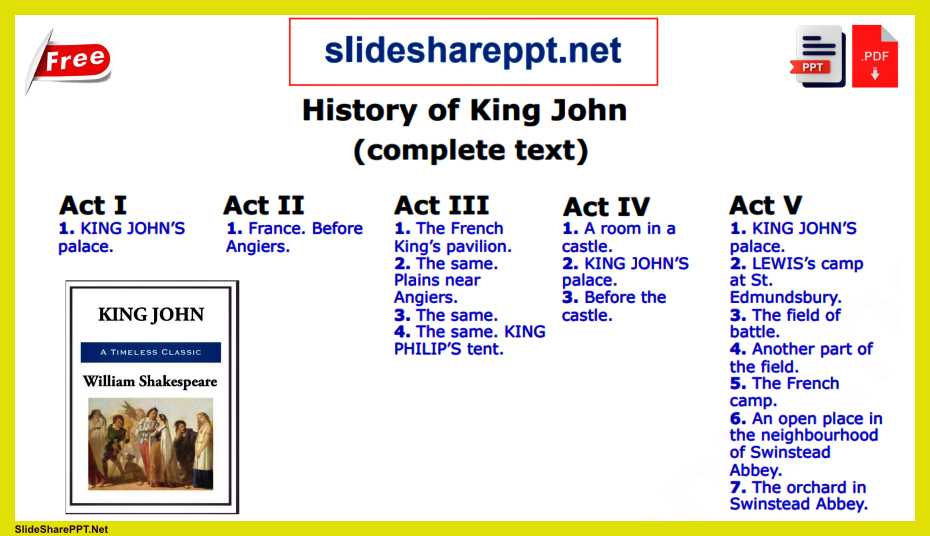
Note: The complete Text PDF Link is at the end of the PowerPoint slides (go to the last PPT Slide)
A Complete Guide to Shakespeare’s “King John”
William Shakespeare’s “King John” is a lesser-known historical drama that offers a fascinating exploration of power, politics, and loyalty during the reign of King John of England. While not as widely studied or performed as some of Shakespeare’s other works, “King John” remains a compelling play that sheds light on a tumultuous period in English history. In this comprehensive guide, we will delve into the plot, characters, themes, and significance of “King John,” offering readers a deeper understanding of this often-overlooked gem of Shakespeare’s canon.
Synopsis:
- “King John” chronicles the events surrounding the reign of King John, who ruled England from 1199 to 1216. The play opens with a dispute over the rightful heir to the throne following the death of King Richard the Lionheart. John’s claim to the throne is contested by his nephew, Arthur, leading to political turmoil and military conflict. As John struggles to maintain his grip on power, he faces challenges from foreign powers, rebellious nobles, and his inner demons. The play culminates in a tragic showdown between John and his adversaries, ultimately leading to his downfall.
Key Characters:
- King John: The titular character and King of England, known for his cunning and ambition, as well as his struggles to assert his authority.
- Prince Arthur: John’s nephew and rival claimant to the throne, whose legitimacy poses a threat to John’s rule.
- Constance: Arthur’s mother and a passionate advocate for her son’s rights, whose grief and desperation drive her to extreme measures.
- Philip the Bastard: A loyal supporter of King John, known for his wit, courage, and unwavering loyalty, despite his illegitimate status.
- Queen Eleanor: John’s mother and a formidable political player, whose influence shapes the course of events throughout the play.
Themes:
- Power and Politics: “King John” explores the ruthless pursuit of power and the Machiavellian tactics employed by rulers to maintain their authority.
- Loyalty and Betrayal: The play examines the complexities of loyalty and betrayal, as characters navigate shifting allegiances and conflicting loyalties.
- Justice and Legitimacy: Questions of justice and legitimacy loom large in “King John,” as characters grapple with issues of rightful inheritance and the rule of law.
- Honor and Reputation: Honor and reputation play a significant role in the characters’ motivations and actions, driving them to acts of valor or treachery.
- Fate and Fortune: The play explores the role of fate and fortune in shaping the destinies of individuals and nations, highlighting the unpredictability of life and politics.
Dramatic Techniques:
- In “King John,” Shakespeare employs a range of dramatic techniques to engage the audience and explore the complexities of power and morality. The use of soliloquies, asides, and dramatic irony allows for insights into the character’s inner thoughts and motivations, creating dramatic tension and emotional depth.
- The play’s structure also showcases Shakespeare’s mastery, with carefully crafted scenes that balance political intrigue, personal conflicts, and moments of introspection. The Battle of Angiers and the confrontation between King John and Cardinal Pandulph are among the memorable set pieces that showcase both grandeur and intimate drama.
Relevance Today:
- While “King John” is firmly rooted in its historical context, its themes and characters resonate with contemporary audiences. The play’s exploration of leadership qualities, the abuse of power, loyalty versus self-interest, and the impact of political decisions on individuals and nations remains relevant in today’s world.
- In an era marked by shifting alliances, populist movements, and debates over the role of authority, “King John” prompts audiences to reflect on timeless questions about ethics, governance, and the responsibilities of those in positions of power. The complexities of characters like King John and the Bastard offer nuanced perspectives on leadership and moral choices that invite comparisons to modern political figures and dilemmas.
Significance:
- “King John” offers valuable insights into the political dynamics and power struggles of medieval England, shedding light on a lesser-known period of history. While the play may not enjoy the same level of popularity as Shakespeare’s more famous works, its exploration of timeless themes and its complex characters make it a rewarding study for readers and audiences alike. Additionally, “King John” serves as a precursor to Shakespeare’s later history plays, foreshadowing themes and techniques that would be further developed in works such as “Henry IV” and “Richard III.”
Conclusion:
- In “King John,” Shakespeare crafts a compelling narrative that combines historical events with timeless themes of power, loyalty, and justice. Through vivid characters and dramatic conflicts, the play offers a rich tapestry of political intrigue and human drama that continues to resonate with audiences today. While “King John” may be less familiar than some of Shakespeare’s other works, its exploration of universal themes and its gripping storytelling ensure its enduring relevance in the world of literature and theater.
- “King John” may not enjoy the same level of popularity as some of Shakespeare’s other plays, but its exploration of political intrigue, personal ambition, and moral dilemmas make it a compelling and relevant work for audiences across centuries. Through vivid characters, complex themes, and masterful dramatic techniques, Shakespeare invites us to ponder timeless questions about power, loyalty, and the human condition, ensuring that “King John” retains its place as a valuable and thought-provoking piece of the Shakespearean canon.
Plot Overview
Here’s a comprehensive table providing a plot overview of William Shakespeare’s “King John”:
| Act | Summary |
|---|---|
| Act 1 | – The play opens with a dispute over the succession to the throne of England following the death of King Richard the Lionheart. – King John, Richard’s younger brother, is declared the rightful heir, despite the competing claim of his nephew, Arthur, the son of John’s deceased elder brother. – France, led by King Philip II, supported Arthur’s claim to the throne, sparking tensions between England and France. |
| Act 2 | – King John faced a rebellion from his nobles, led by the Earl of Essex and the Bastard of Faulconbridge, who resent his heavy-handed rule and questionable legitimacy as king. – John’s mother, Queen Eleanor, seeks to maintain stability and uphold her son’s authority, while Arthur’s mother, Constance, pleads for her son’s rights and vows revenge against John. – The Bastard of Faulconbridge emerges as a key figure, displaying loyalty to King John despite his illegitimate status. |
| Act 3 | – War breaks out between England and France as King Philip II supports Arthur’s claim to the English throne. – John’s forces, led by the Bastard of Faulconbridge, achieved victory over the French at the Battle of Angiers. – However, tensions rise within England as John faces challenges from both foreign powers and rebellious nobles. – Constance mourns the loss of her son Arthur and blames King John for his death, cursing him with her dying breath. |
| Act 4 | – The conflict between England and France escalates as King John seeks to solidify his hold on the throne. – John forms an alliance with the papal legate, Pandulph, to secure his position, leading to a confrontation with the forces of France and the papacy. – Despite his efforts to maintain control, John faces betrayal from within his ranks, as the Earl of Salisbury defects to the French side, further complicating the political landscape. |
| Act 5 | – The climax of the play occurs with the Battle of Swinstead, where King John’s forces suffer a devastating defeat at the hands of the French. – In a moment of desperation, John seeks refuge in the monastery of Swinstead Abbey, where he falls ill and ultimately dies. – The play ends with the ascension of John’s son, Prince Henry, to the throne of England, marking the resolution of the succession crisis and the beginning of a new era for the kingdom. – The Bastard of Faulconbridge, now reconciled with his noble lineage, pledges his loyalty to the new king, ensuring the stability of the realm. |
This table provides a structured summary of the main events and developments in each act of “King John,” capturing the essence of the play’s intricate plot and dramatic tension.
Key Characters
Here’s a comprehensive table outlining the key characters in William Shakespeare’s “King John”:
| Character | Description and Role |
|---|---|
| King John | The titular character and King of England, known for his controversial reign and struggles to maintain power amidst internal and external threats. John’s decisions and actions drive much of the plot’s conflict and shape the fate of the kingdom. |
| Prince Arthur | John’s young nephew and rival claimant to the throne of England. Arthur’s legitimacy as an heir poses a threat to John’s rule and becomes a focal point of political tension and military conflict throughout the play. |
| Constance | Arthur’s mother and a passionate advocate for her son’s rights. Constance’s grief over Arthur’s fate drives her to extremes, and her fierce loyalty to her son shapes her interactions with other characters, contributing to the play’s emotional intensity. |
| Philip the Bastard | A charismatic and resourceful nobleman, known for his wit, courage, and loyalty to King John. Despite his illegitimate status, the Bastard plays a crucial role in defending England against its enemies and navigating the treacherous political landscape of the time. |
| Queen Eleanor | King John’s mother and a formidable political player in her own right. Queen Eleanor’s influence over her son and her strategic maneuvering behind the scenes shape the course of events throughout the play, making her a key figure in the unfolding drama. |
| Cardinal Pandulph | The papal legate sent to England by the Pope, Pandulph wields significant religious authority and acts as a mediator in the conflict between King John and the forces of France. His role as a representative of the Church adds a layer of complexity to the political and moral dimensions of the play. |
| The Earl of Salisbury | A nobleman who initially serves King John but later defects to the French side, becoming a key antagonist in the struggle for power. Salisbury’s betrayal underscores the fragility of allegiances and the ever-shifting loyalties among the nobility in the turbulent world of “King John.” |
| The Bastard’s Mother | Although unnamed in the play, the Bastard’s mother plays a pivotal role in shaping her son’s identity and values. Her revelation of the Bastard’s true parentage and her proud declaration of his noble lineage contribute to his development as a character and his ultimate reconciliation with his heritage. |
This table offers insights into the key characters in “King John,” their motivations, relationships, and roles within the play’s intricate plot.
Themes
Here’s a comprehensive table outlining the key themes of William Shakespeare’s “King John”:
| Theme | Description |
|---|---|
| Power and Authority | “King John” explores the dynamics of power and authority, depicting the struggles of rulers to maintain control amidst political turmoil and internal dissent. The play examines the legitimacy of rulership and the consequences of wielding power unchecked. |
| Loyalty and Betrayal | Loyalty and betrayal are central themes in “King John,” as characters navigate shifting allegiances and conflicting loyalties. The play explores the complexities of loyalty to family, country, and personal ambition, and the consequences of betrayal on individuals and society. |
| Honor and Reputation | Honor and reputation play a significant role in the characters’ motivations and actions in “King John.” Characters are driven by a desire to uphold their honor and preserve their reputations, leading them to acts of valor or treachery with far-reaching consequences. |
| Justice and Morality | Questions of justice and morality loom large in “King John,” as characters grapple with issues of rightful inheritance, divine judgment, and ethical conduct. The play examines the tension between legal justice and divine justice and the moral implications of political ambition. |
| Fate and Fortune | “King John” explores the role of fate and fortune in shaping the destinies of individuals and nations. Characters confront the unpredictability of life and politics, grappling with the notion of destiny and the consequences of their actions in the face of uncertain futures. |
| War and Conflict | War and conflict are recurring motifs in “King John,” as England and France engage in military battles over issues of succession and territorial disputes. The play depicts the brutality and chaos of war and its profound impact on individuals and societies caught in its grip. |
This table provides a comprehensive overview of the central themes explored in “King John,” offering insights into the play’s exploration of power dynamics, morality, and the human condition.
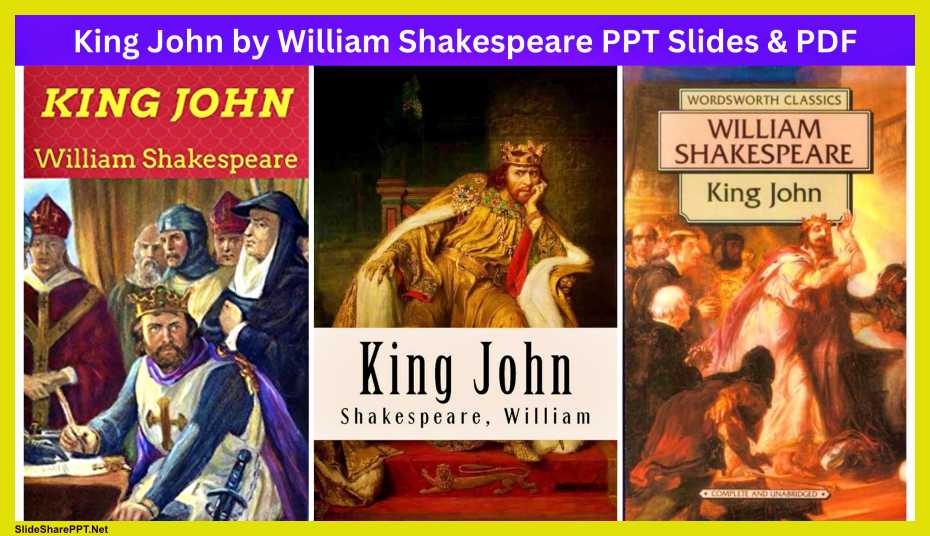
Significance
Here’s a comprehensive table highlighting the significance of William Shakespeare’s “King John”:
| Aspect | Significance |
|---|---|
| Historical Context | “King John” provides insights into the political turmoil of the late 12th and early 13th centuries, offering a dramatized account of the reign of King John of England. The play sheds light on the power struggles, conflicts, and alliances of the period, contributing to our understanding of medieval English history. |
| Political Intrigue | The play explores themes of power, legitimacy, and authority, depicting the Machiavellian tactics employed by rulers to maintain control amidst political turmoil. “King John” offers a nuanced portrayal of political intrigue and the complexities of governance, providing valuable insights into the nature of power and the dynamics of rulership. |
| Character Dynamics | Through vivid characters and dramatic conflicts, “King John” offers a rich tapestry of human drama, showcasing the complexities of loyalty, betrayal, and ambition. The interactions between characters such as King John, Prince Arthur, and the Bastard of Faulconbridge illuminate timeless themes of honor, family, and duty. |
| Cultural Influence | While “King John” may not enjoy the same level of popularity as some of Shakespeare’s other works, its exploration of universal themes and its gripping storytelling ensure its enduring relevance in the world of literature and theater. The play continues to be studied, performed, and adapted for modern audiences around the globe. |
| Precursor to Later Works | “King John” serves as a precursor to Shakespeare’s later history plays, foreshadowing themes and techniques that would be further developed in works such as “Henry IV” and “Richard III.” The play’s exploration of political intrigue and its portrayal of flawed yet compelling characters laid the groundwork for Shakespeare’s later masterpieces. |
This table offers insights into the significance of “King John” within both its historical context and its broader cultural and literary impact.
Also read: Auto journalism
Act and Scene Summary
King John: Shakespeare’s Exploration of Power and Moral Ambiguity.
- “King John,” one of William Shakespeare’s lesser-known historical dramas, offers audiences a compelling portrayal of political intrigue, moral ambiguity, and the complexities of power. Set during the reign of King John of England in the early 13th century, the play delves into the turbulent events surrounding John’s reign, including his disputes with France, his conflicts with the Pope, and his struggle to maintain control over his kingdom. Through its vivid characters, intricate plot, and thought-provoking themes, “King John” provides a fascinating glimpse into a lesser-known chapter of English history while exploring timeless questions of leadership, loyalty, and the nature of authority.
- At the heart of the play lies the character of King John, whose reign is marked by both ambition and insecurity. As John grapples with internal dissent and external threats, he emerges as a complex and conflicted figure, torn between his desire for power and his fear of losing it. Shakespeare’s portrayal of John as a flawed and morally ambiguous ruler invites audiences to ponder the nature of leadership and the challenges of governance in a world fraught with uncertainty and betrayal.
- Central to the narrative is John’s contentious relationship with his nephew, Arthur, whose claim to the throne threatens to undermine John’s authority. As John seeks to suppress Arthur’s rebellion and secure his hold on power, he becomes embroiled in a web of deceit and treachery that will ultimately lead to tragedy. Through John’s interactions with Arthur, his mother Constance, and his loyal supporters, Shakespeare explores themes of family loyalty, political ambition, and the price of power with remarkable depth and nuance.
- Equally compelling are the supporting characters who populate the world of “King John,” including the cunning Cardinal Pandulph, the steadfast Earl of Salisbury, and the fiery Bastard, whose loyalty to King John is tested by his sense of honor and justice. Each character brings their own motivations and agendas to the forefront, contributing to the atmosphere of tension and intrigue that pervades the play. As alliances shift and loyalties are tested, Shakespeare invites audiences to ponder the nature of loyalty and the moral complexities of political allegiance.
- The play’s exploration of the tensions between church and state is particularly relevant in today’s world, where questions of religious authority and political power continue to shape the course of history. As John clashes with the Pope over the appointment of the Archbishop of Canterbury and the issue of papal authority, Shakespeare confronts audiences with the enduring struggle for control between secular and ecclesiastical institutions. Through John’s conflicts with the church, Shakespeare offers a nuanced exploration of the complexities of religious and political authority and the competing claims to legitimacy that define the era.
- Ultimately, “King John” stands as a compelling exploration of power, loyalty, and the moral ambiguities of leadership. Through its vivid characters, stirring dialogue, and thought-provoking themes, the play invites audiences to ponder the timeless dilemmas of governance and the challenges of navigating the murky waters of politics and power. As we journey with King John and his adversaries through the trials and tribulations of medieval England, we are reminded of the enduring relevance of Shakespeare’s exploration of the human condition and the complexities of history.
Characters Descriptions and Roles
Below is a table providing descriptions and roles of key characters in William Shakespeare’s “King John”:
| Character | Description and Role |
|---|---|
| King John | The titular character and King of England, known for his controversial reign and struggles to maintain power amidst internal and external threats. John’s decisions and actions drive much of the plot’s conflict and shape the fate of the kingdom. |
| Prince Arthur | John’s young nephew and rival claimant to the throne of England. Arthur’s legitimacy as an heir poses a threat to John’s rule and becomes a focal point of political tension and military conflict throughout the play. |
| Constance | Arthur’s mother and a passionate advocate for her son’s rights. Constance’s grief over Arthur’s fate drives her to extremes, and her fierce loyalty to her son shapes her interactions with other characters, contributing to the play’s emotional intensity. |
| Philip the Bastard | A charismatic and resourceful nobleman, known for his wit, courage, and loyalty to King John. Despite his illegitimate status, the Bastard plays a crucial role in defending England against its enemies and navigating the treacherous political landscape of the time. |
| Queen Eleanor | King John’s mother and a formidable political player in her own right. Queen Eleanor’s influence over her son and her strategic maneuvering behind the scenes shape the course of events throughout the play, making her a key figure in the unfolding drama. |
| Cardinal Pandulph | The papal legate sent to England by the Pope, Pandulph wields significant religious authority and acts as a mediator in the conflict between King John and the forces of France. His role as a representative of the Church adds a layer of complexity to the political and moral dimensions of the play. |
| The Earl of Salisbury | A nobleman who initially serves King John but later defects to the French side, becoming a key antagonist in the struggle for power. Salisbury’s betrayal underscores the fragility of allegiances and the ever-shifting loyalties among the nobility in the turbulent world of “King John.” |
| The Bastard’s Mother | Although unnamed in the play, the Bastard’s mother plays a pivotal role in shaping her son’s identity and values. Her revelation of the Bastard’s true parentage and her proud declaration of his noble lineage contribute to his development as a character and his ultimate reconciliation with his heritage. |
These descriptions offer insights into the key characters in “King John,” their motivations, relationships, and roles within the play’s intricate plot.
Key Quotes and Lines
Here’s a table featuring key quotes and lines from William Shakespeare’s “King John”:
| Character | Quote |
|---|---|
| King John | “Life is as tedious as a twice-told tale, / Vexing the dull ear of a drowsy man.” |
| Prince Arthur | “O me! my uncle’s spirit is in these stones: / Heaven take my soul, and England keep my bones!” |
| Constance | “Grief fills the room up of my absent child, / Lies in his bed, walks up and down with me, / Puts on his pretty looks, repeats his words, / Remembers me of all his gracious parts, / Stuffs out his vacant garments with his form.” |
| Philip the Bastard | “Mad world! mad kings! mad composition!” |
| Queen Eleanor | “What scene of death hath Roscius now to act?” |
| Cardinal Pandulph | “A short time to consider is allowed.” |
| The Bastard’s Mother | “I am the mother of good-will; and I am the mother of knaves.” |
| The Earl of Salisbury | “Fie, what a slug is Hastings, that he comes not / To tell us whether they will come or no!” |
These quotes capture the essence of “King John,” showcasing the eloquence and depth of Shakespeare’s language while highlighting the key themes and characters within the play.
Q&A:
Q: Who was King John?
- A: King John, also known as John Lackland, was the King of England from 1199 until his death in 1216. He was the youngest son of King Henry II and Eleanor of Aquitaine and is best known for his involvement in the signing of the Magna Carta, a document that limited the powers of the monarchy and established certain rights for the English nobility.
Q: What is the historical significance of King John?
- A: King John’s reign was marked by political turmoil, military conflicts, and disputes with the nobility. His reign saw the loss of English territories in France, as well as confrontations with the Pope over the appointment of bishops. Additionally, King John’s actions led to widespread discontent among the barons, culminating in the signing of the Magna Carta in 1215, which laid the foundations for constitutional monarchy in England.
Q: How does Shakespeare portray King John in his play?
- A: In Shakespeare’s play “King John,” the titular character is depicted as a complex and flawed ruler. He is shown as ambitious and manipulative, willing to use deceit and violence to maintain his grip on power. However, he is also portrayed as vulnerable and plagued by doubts and insecurities, particularly in his interactions with his family and advisors.
Q: What role does the character of Prince Arthur play in the play?
- A: Prince Arthur, John’s young nephew and rival claimant to the throne, serves as a central figure in the conflict surrounding the succession. Arthur’s legitimacy as an heir poses a threat to John’s rule, leading to political turmoil and military conflict. His fate becomes a focal point of the play, as characters grapple with issues of loyalty, justice, and morality.
Q: What are some of the key themes explored in “King John”?
- A: “King John” explores themes such as power and authority, loyalty and betrayal, justice and morality, honor and reputation, and the unpredictable nature of fate and fortune. The play also delves into the complexities of family relationships and the dynamics of political intrigue, offering insights into the human condition and the challenges of leadership.
Q: How does “King John” compare to Shakespeare’s other historical plays?
- A: “King John” is often considered one of Shakespeare’s lesser-known history plays, but it shares many thematic and stylistic similarities with his other works in the genre. Like his other history plays, “King John” explores issues of power, politics, and leadership, while also offering rich characterizations and dramatic conflicts. However, “King John” stands out for its focus on a lesser-known period of English history and its portrayal of a complex and enigmatic monarch.
Read the Previous Post: Henry VIII by William Shakespeare PPT Slides & PDF
